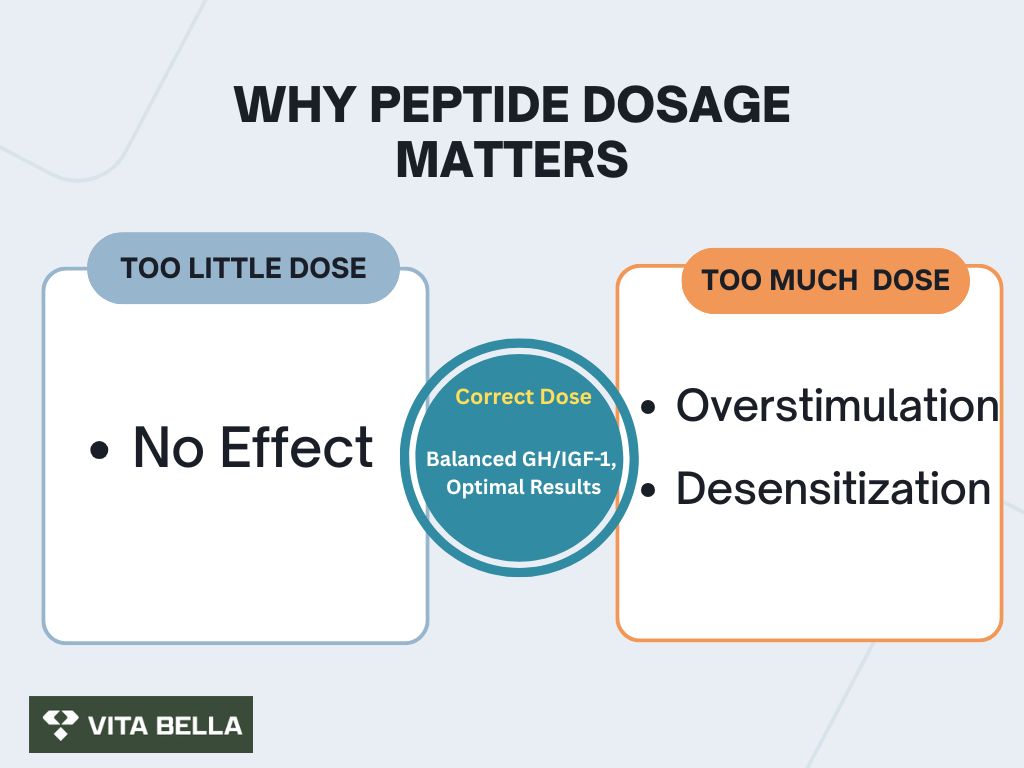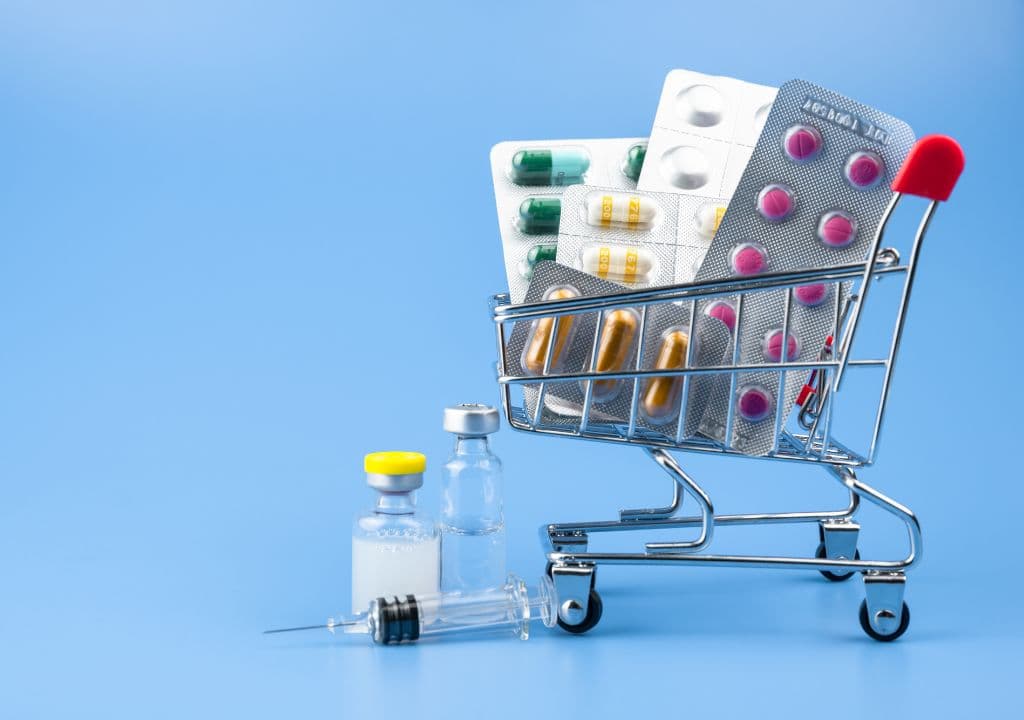Peptides may be powerful, but without precise dosing, they can tip the body’s delicate GH/IGF-1 balance from healing to harm.
Correct dosage matters dramatically for peptides because they act through delicate hormonal pathways 1: too little gives no physiological effect; too much risks overstimulation, desensitization, or adverse side effects. The GH/IGF-1 axis is highly sensitive to small changes in GH or IGF-1 2 levels, which can trigger feedback suppression or amplify downstream effects.
Because IGF-1 is a central mediator of GH’s effects, even minor deviations can disproportionately alter metabolism, growth, and repair processes. In metabolic and nutritional regulation, the GH/IGF-1 system responds dynamically to nutrient status and metabolic signals; therefore, peptide dosing must be tailored to an individual’s biochemistry 3.
Peptide therapy isn’t one-size-fits-all; it’s precision science. Vita Bella designs protocols that keep your GH/IGF-1 axis in balance while unlocking peak performance. Discover the power of tailored dosing now.
Basic Concepts about Peptide Delivery and Strengths
Parenteral delivery 4 is any route of administering medication or nutrition that bypasses the gastrointestinal tract, meaning it's given outside the digestive system. Common parenteral methods include injections into veins (intravenous or IV), muscles (intramuscular), or under the skin (subcutaneous). Subcutaneous administration is the most common route for peptides and proteins because it bypasses gastrointestinal degradation and absorption barriers, thus preserving bioactivity. However, peptides are inherently unstable in aqueous solutions, susceptible to hydrolysis, aggregation, oxidation, and deamidation, making formulation critical for stability.
To overcome these challenges, strategies 5 such as pH optimization, use of stabilizing excipients (buffers, antioxidants, surfactants), lyophilisation, and controlled storage conditions are employed.
The design of peptide formulations directly impacts dosage accuracy, shelf life, and injection safety in clinical and performance settings.
CJC-1295 Dosage Guidelines
1- Common dose ranges:
In human trials, 6 doses of 30 or 60 µg/kg subcutaneously showed safe and sustained GH/IGF-1 elevation.
2- Frequency/protocols:
CJC-1295 has been dosed weekly or biweekly in clinical studies, and with multiple administrations, IGF-1 levels remained elevated for up to 28 days.
3- Safety:
Trials 7 reported no serious adverse events at the studied ranges. There appears to be a cumulative effect with repeated doses, so exceeding the tested doses risks unknown side effects.
Ipamorelin Dosage Guidelines
1- Typical dosing ranges:
According to studies 8, Ipamorelin has been used to promote bone growth at experimental doses. In humans, it’s established as a selective GH secretagogue 9 with minimal off-target hormone effects even at doses far above the effective GH dose.
2- Timing & split dosing:
Because Ipamorelin induces pulsatile GH, many protocols favor pre-bed, pre-workout, or split dosing (morning + evening) to mirror natural GH rhythms.
Beginners may start with a single dose before bed (e.g., lower µg), while advanced users may use multiple injections daily (morning and pre-bed) or increase the dose gradually.
Stacking Strategy: CJC-1295 + Ipamorelin Together
Stacking is done to combine the baseline elevation from a GHRH analogue with pulsatile GH bursts from a secretagogue, achieving synergy that often leads to greater GH response 10 than either alone. Clinical and review sources note that secretagogues are generally well-tolerated, and combining them with GHRH analogues can enhance GH 11 output more reliably.
Older reviews of GH-releasing peptides emphasize that combining forms leverages both sustained and pulse release patterns to optimize metabolic and anabolic effects.
Suggested stacking strategies often utilize lower doses of CJC-1295 as the baseline, with periodic Ipamorelin pulses (e.g., around training or nightly) to minimize waste and side effects. When only one goal is prioritized, such as metabolism/fat loss, or recovery, some individuals may use either CJC-1295 or Ipamorelin, rather than both.
Safety, Monitoring & Adjustments
You should begin with baseline labs, including IGF-1 / GH axis 12, complete blood count (CBC), metabolic panel (glucose, lipids), liver and kidney function, to detect any underlying issues. In preclinical studies, ipamorelin has effects independent of GH, which underscores the need to monitor metabolic markers.
During use, adjust doses based on lab trends or symptoms such as IGF-1 overshoot, edema, glucose disturbances, or fatigue. If IGF-1 becomes excessively high, reduce the dose or frequency. In study 7, doses of CJC-1295 were escalated carefully with good tolerance, and no serious adverse events were reported in the studied dose ranges. “Warning signs” to discontinue include symptoms of GH excess (joint pain, swelling, insulin resistance) or organ stress. The safety review 13 of secretagogues notes that long-term data is limited, so vigilance is essential.
The Smarter Way to Heal, Burn Fat, and Boost Energy with Vita Bella
When hormone pathways become imbalanced, the results include slow healing, weight gain, and low vitality. Vita Bella specializes in personalized peptide solutions, such as CJC-1295 + Ipamorelin, to safely revitalize your body’s growth and repair processes. Let us help you restore balance, performance, and long-term wellness with expert care.
FAQs
1. How do CJC-1295 and Ipamorelin work together?
CJC-1295 provides a sustained release of growth hormone by stimulating GHRH receptors, while Ipamorelin triggers short, natural GH pulses. When combined, they mimic the body’s natural rhythms, delivering both steady and pulsatile growth hormone release for enhanced metabolism, recovery, and energy.
2. Are CJC-1295 and Ipamorelin safe to use long-term?
Clinical studies suggest these peptides are generally well-tolerated within tested dose ranges, with minimal side effects. However, because long-term human data is limited, ongoing monitoring of IGF-1 levels, glucose, and overall health is strongly recommended.
3. Who can benefit from peptide therapy with CJC-1295 and Ipamorelin?
Individuals experiencing fatigue, slow recovery, weight management challenges, or signs of age-related decline may benefit. Since response varies by individual, a personalized plan based on lab results and health goals is essential for safe and effective outcomes.

References:
Wu, B., & Yu, Y. (2021). Mitochondria dysfunction and metabolic perturbation in diabetic kidney disease. Frontiers in Physiology, 12, 649891. https://doi.org/10.3389/fphys.2021.649891
Jain, D., Mahammad, S. S., Singh, P. P., & Kodipyaka, R. (2019). A review on parenteral delivery of peptides and proteins. Drug Development and Industrial Pharmacy, 45(9), 1403–1420. https://doi.org/10.1080/03639045.2019.1628770
Sigalos, J. T., & Pastuszak, A. W. (2017). The safety and efficacy of growth hormone secretagogues. Sexual Medicine Reviews, 6(1), 45–53. https://doi.org/10.1016/j.sxmr.2017.02.004





















